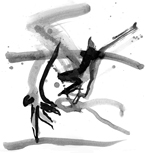|
From 1965 to 1967, I was at the University of Iowa’s Writers Workshop. While the Workshop provided courses in writing poetry and fiction, a student was encouraged to take other classes. Thus I had the great pleasure of reading Remembrance of Things Past with the Proustian Chilean novelist José Donoso, who in another course introduced us to the world of Latin American writing—most memorably, Juan Rulfo’s Pedro Páramo and Pablo Neruda’s poetry.
And then there was Ch’eng Hsi, who taught Chinese poetry, painting, and opera. It was the time of the Vietnam war, the draft, and President Johnson. Our country was in torment and turmoil. The experience of ancient China had resonances for us. The poems were about war and disagreement with the emperor and exile. Ch’eng—probably then in his forties—would recite, emote, really sing a poem in ancient Chinese, as we took up his sweet-smelling, narcotic ditto sheets with their purple letters and silently read the poem in three versions: in calligraphy, in transliteration, and in rough translation. I still remember the vivid sounds of the originals.
When I left Iowa for New York, I brought along my notes and ditto sheets, planning to make something of them someday. It was not until 1990, however, after more than two decades of writing, editing, and translating, that I felt ready to tackle the material. A hundred pages finally became a nine-poem sequence of moods and themes, of history, greed, bitterness, ecstasy.
I have always loved both drawing and writing but gave up visual arts in my twenties to concentrate on writing. In the 1980s I started drawing and painting again, usually in connection with some performance work, like the dance libretto to music of Olivier Messiaen The Re-Creation of the New World, recently published in Scene4, and Helen Adam’s ballad opera San Francisco’s Burning, recently published in Jacket2. In May 1996 I made the drawings for “The Song of the Earth” using a Chinese inkbrush that I had bought thirty years before at Ch’eng’s suggestion. The aim was to make a visual, calligraphic, representational image of each poem, if possible conveying the music and movement of the original material.
|
|
|
